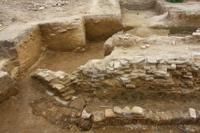You are here
Asanas ancient settlement.

All monuments of history and culture of Kazakhstan.
"History abhors frivolity,
Her folk path is difficult.
Her blood-stained pages
You can't love with thoughtless love
And you can't not love without memory"
Monuments of history and culture Southern Kazakhstan.
The Asanas settlement is located on the left bank of the Syrdarya river, 8.7 kilometers west of the Aydarly village, 44.7 kilometers southeast of the city of Kyzylorda in the upper reaches of the Inkardarya in the Syrdarya district of the Kyzylorda region.
Written sources report it as a city that resisted and was conquered by the troops of Jochi in 1219. The settlement is located on the bank of the dry river Asanas-Uzyak. It has an irregular shape and is surrounded by a shaft up to 5 meters high.
A citadel was located in the eastern part of the settlement. Now it is a hillock with a diameter of up to 50 meters and a height of 1 meter. Thanks to archaeological research, it has been established that life in Asnas continued from the first centuries AD. e. until the 15th century. (Vakturskaya 1979: 127 - 133).
A group of ceramics related to the culture of the Oguzes, Kipchaks and the Golden Horde was collected (Baypakov 1998: 74). The mound in plan is an irregular structure close to an oval, in places with breaks or straight sections.
The preserved height of the shaft is up to 4 meters. The shaft width varies greatly, reaching up to 20 meters. The entrance to the settlement, fortified by a vestibule-type structure, is located on the western side. Inside the settlement, the remains of structures can be traced in the form of swollen mounds, small sub-square hills.
The remains of burnt brick structures excavated in due time, located in the central part of the settlement closer to the southern wall, are of interest. The structures are round in plan, the walls are up to two meters thick. The preserved height of the structures is up to 1.5 meters. Inside one of the structures on the north side there is a crypt made of bricks.
The settlement is the ruins of a large fortified medieval city surrounded by a powerful wall with towers. The approximate size of the city is 480 x 450 meters. In terms of the site of the ancient settlement, it is of an irregular oval shape. In three places on the wall, traces of foundations of later mazars were found.
The gate, fortified by a gateway, is located in the northern, eastern and western walls, in addition, there is an entrance from the south, but not so fortified. Outside, the settlement is surrounded by a large moat. In the eastern part of the settlement there is a citadel in the form of a hillock with round slopes, with an area of 40 x 50 meters.
The stratigraphic pit at the Asanas site made it possible to determine that the site had been inhabited already in the 7th - 9th centuries. and lives up to the 15th century. Of the industrial buildings, the well-preserved structures of the brick kiln can be noted.
The ceramic material obtained in the course of the research allowed the researchers to date the period of the city's functioning from the time of “swamp settlements” to the XVth century. According to N.N. Vaktursky, the reason for leaving the city is associated with changes in the water regime of the Syr Darya region. S.P. Tolstov noted that, most likely, in the XVth century. the modern channel of the Syrdarya was formed, and its ancient southern channels - Zhanadarya and Inkardarya began to wither away.
Geographic coordinates of the Asanas settlement: N44 ° 27'50.72 "E65 ° 39'16.44"
Authority:
Bartold V. V. "Towards the history of irrigation of Turkestan." Collected works, v. III. - M., 1965. Tolstov S. P. "In the footsteps of the ancient Khorezm civilization." M., 1948. Tolstov S.P. “Along the ancient deltas of the Oxus and Yaxart”. M., 1962. Andrianov B.V. "Ancient irrigation systems of the Aral Sea region". M., 1969 Vakturskaya N. N. "New data about the city of Asanas". Archeology and Ethnography of Central Asia. M., 1979.







